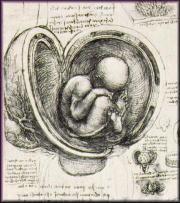
| Reproduction Index | Glossary |
|---|
 |
Implantation and Development of the Placenta: Introduction and Index |

Throughout gestation, the mammalian embryo is a parasite that survives "at the pleasure" of its mother. Early in gestation, the embryo is small and has correspondingly small requirements for nutrients and for waste disposal systems - it subsists by taking up endometrial secretions and dumping its metabolic wastes into the lumen of the uterus. This situation changes rapidly. As the embryo grows and develops a vascular system, it must establish a much more efficient means of obtaining nutrients and eliminating waste products, and does so by establishing an efficient interface between its vascular system and that of its mother. That interface is the placenta. In addition to its primary goal of facilitating transport between mother and fetus, the placenta is also a major endocrine organ. In almost all mammals the placenta synthesizes and secretes steroid hormones - progestins and estrogens. The placenta also produces a number of protein hormones. Depending on the species, it is the source of chorionic gonadotropins, relaxin, and placental lactogens. Placental hormones have profound effects on both fetal and maternal physiology. Despite the fact that all placentae carry out the same basic processes of transport and hormone secretion, there are important differences in structure and function among families of mammals. The placentae of humans, cattle, horses and dogs are all very different from one another at both gross and histologic levels. They also differ in certain functions that are clinically important - for example, in the ability to transport maternal immunoglobulins to the fetus. Core concepts related to implantation and placentation are presented in the following topics:
Advanced and supplemental topics related to implantation and placentation are:
|
Last updated on March 25, 2001 |
| Author: R. Bowen |
| Send comments via form or email to rbowen@colostate.edu |